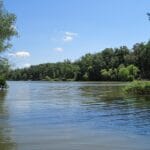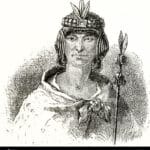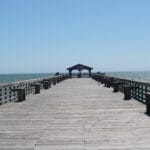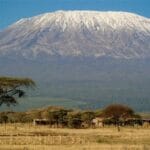Come discover the captivating Homolovi Ruins State Park, an Arizona treasure where whispers of ancient civilizations mingle with the desert wind. Nestled within the stark beauty of the Sonoran Desert, this enchanting park invites you to unravel the secrets of the past while immersing yourself in the timeless landscape. Our journey will uncover the captivating history of Homolovi, explore its remarkable sites, and provide all the practical details needed to make your visit truly unforgettable.
A Journey Through Time: Exploring Homolovi’s Ancestral Villages
Imagine a place where crumbling walls whisper tales of a vibrant civilization, a place where the vast desert sky seems to stretch back through centuries. This is Homolovi Ruins State Park, a captivating blend of history, nature, and spiritual significance located just north of Winslow, Arizona.
Homolovi, meaning “place of the little hills” in the Hopi language, is more than just a collection of ruins. It’s a living testament to the ingenuity and resilience of the Ancestral Puebloan people who thrived here between the 13th and 14th centuries. Walk among the remnants of their homes and catch a glimpse of daily life in this challenging environment. The park safeguards over 300 archaeological sites, each a piece of the puzzle that helps us understand this fascinating culture. For the Hopi people, Homolovi holds a particularly deep meaning, as they believe it to be the ancestral home of their clans – a place where the past isn’t just remembered, it’s felt.
Key Sites and Activities: Bringing the Past to Life
Homolovi I and Homolovi II, two of the park’s most accessible village sites, offer an excellent starting point for exploration. As you wander through these ruins, it’s easy to envision the hustle and bustle of daily life – families cooking meals, children playing, and craftspeople creating beautiful pottery. The park’s museum further enriches the experience by showcasing artifacts unearthed from the sites. From everyday tools to stunning examples of ancient artistry, these objects help forge a tangible connection to the people who once called this place home.
For a more in-depth understanding, guided tours are highly recommended. Knowledgeable guides offer valuable insights into the history, culture, and significance of Homolovi, pointing out details you might otherwise miss and sharing intriguing theories about the Ancestral Puebloans’ lives. Discover the possible reasons for their settlement here and the mysteries surrounding their eventual departure. With research at Homolovi ongoing, our understanding of these ancient people continues to evolve.
But Homolovi isn’t solely focused on the past. The park, nestled along the life-giving Little Colorado River, boasts a stark yet captivating beauty. The surrounding desert, though seemingly harsh, teems with life – from the vibrant birdlife that fills the air with song to the subtle beauty of desert-adapted plants. Several hiking trails wind through the park, offering opportunities to explore this unique ecosystem and soak in the tranquility of the desert. For a truly immersive experience, consider camping beneath the immense, star-studded sky and let the whispers of the past lull you to sleep.
| Feature | Details |
|---|---|
| Location | Just north of Winslow, Arizona |
| Hours | Sunrise to Sunset, Daily, Year-round |
| Activities | Exploring ruins, hiking, birdwatching, camping, guided tours, museum visits |
| Amenities | Campground, museum, gift shop, restrooms |
| Accessibility | Accessible features available, inquire at the visitor center |
Unraveling the Mysteries of Homolovi’s History
Let’s delve deeper into the layers of Homolovi’s fascinating history, a timeline spanning centuries filled with thriving communities, unexplained disappearances, and the struggle to preserve this precious piece of the past.
Our story begins in the 13th century. The Little Colorado River, a lifeline in the arid landscape, attracted the Ancestral Puebloan people. Skilled builders and farmers, they recognized the potential of this land and established villages that archaeologists now refer to as Homolovi I, II, III, and IV. They constructed impressive pueblos, kivas (ceremonial structures), and ingenious irrigation systems that speak to their deep understanding of the environment.
Then, sometime around the late 14th century, something shifted. The settlements were abandoned. Why? That’s one of the biggest mysteries surrounding Homolovi. Archaeologists propose several theories: Was it a prolonged drought that led to crop failure and dwindling water sources? Did the land become overused, or essential resources, like timber, become scarce? While inter-group conflict is possible, evidence for this at Homolovi is less conclusive. Perhaps a combination of factors led to the exodus. The truth is, we may never know for sure, and that’s part of what makes Homolovi so intriguing.
For centuries, Homolovi lay quiet, its stories buried beneath the desert sand. Then, in the early 20th century, it was rediscovered. Sadly, this rediscovery wasn’t entirely positive. In the 1960s, looters, driven by greed and a disregard for history, descended upon the site, using heavy machinery that damaged irreplaceable burials and kivas in their search for artifacts.
Fortunately, this destruction sparked public outrage. People recognized that Homolovi was more than just a collection of ruins; it represented a crucial link to the past. This groundswell of support led to the establishment of Homolovi Ruins State Park in 1986, marking a turning point from exploitation to preservation.
Today, Homolovi State Park serves as a living classroom, connecting visitors with the past. Archaeological research continues, slowly piecing together Homolovi’s story. Educational programs bring the site to life, sharing its significance with people of all ages. Homolovi, with its enduring mysteries and resilience, continues to inspire curiosity and wonder in all who visit.
| Time Period | Event | Possible Reasons/Impact |
|---|---|---|
| 13th Century | Arrival and settlement of Ancestral Puebloan people | Drawn by fertile land along the Little Colorado River |
| Late 14th Century | Abandonment of Homolovi settlements | Drought, resource scarcity, inter-group conflict (less likely) |
| Early 20th Century | Rediscovery of the Homolovi site | Renewed interest in the region’s archaeological history |
| 1960s | Extensive looting and damage to the site | Loss of artifacts and damage to structures |
| 1986 | Establishment of Homolovi Ruins State Park | Protection of the site and its cultural heritage |
| Present | Ongoing research, preservation efforts, and educational programs | Deeper understanding of Homolovi and its significance |
It’s worth noting that our understanding of Homolovi is constantly evolving. What we know today might be refined or even challenged by future discoveries.
Homolovi and its Connection to the Hopi People
The story of Homolovi is intricately woven with the history of the Hopi people. While the park sits just north of the Navajo Nation, the largest Native American reservation in the United States, it’s important to understand the deeper cultural connections in this area.
For the Hopi, Homolovi is not just a place of ancient ruins, but a tangible link to their ancestors. They believe their people migrated from these very villages, carrying with them their traditions, language, and spiritual practices. The Hopi term “Homol’ovi” translates to “place of the little hills,” a name that reflects the defining characteristic of the landscape.
This connection is not just a matter of oral history. Archaeologists and researchers have discovered numerous cultural links between the pottery styles, architectural techniques, and ceremonial practices found at Homolovi and those still practiced by the Hopi today. Did you know that Homol’ovi has a close connection with the mallqui incas? Come explore the ruins and their fascinating stories of travel and culture.
Visiting Homolovi, therefore, offers a unique opportunity to not just learn about the past, but to understand its living legacy. The stories of the Ancestral Puebloans are not confined to history books; they continue to resonate through the beliefs, traditions, and cultural identity of the Hopi people.
| Site | People/Tribe | Significance | Distance from Winslow (approx.) |
|---|---|---|---|
| Navajo Nation | Navajo People | Largest Native American reservation in the U.S., rich contemporary culture. | North of Winslow |
| Homolovi Ruins State Park | Ancestral Puebloans (Hopi ancestors) | Preserved ruins of ancient villages. | Just north of Winslow |
A visit to Homolovi Ruins State Park offers a powerful way to connect with that history and appreciate the rich cultural tapestry of the region. Remember to be respectful of the cultures and traditions of the people whose ancestral lands you are visiting.
Planning Your Visit to Homolovi Ruins State Park
Homolovi Ruins State Park, located just a mile north of Winslow, Arizona, is easily accessible to travelers exploring the American Southwest. The park encompasses 4,500 acres and provides a glimpse into a civilization that thrived along the Little Colorado River centuries ago. Here’s what you need to know to plan your visit:
Getting There: Homolovi Ruins State Park is located on Highway 87, just north of Winslow. It’s a short detour off the historic Route 66, making it an easy addition to any Arizona road trip.
When to Visit: Homolovi Ruins State Park is open year-round from sunrise to sunset. Summers can be hot, so visiting during the spring or fall offers milder temperatures and the opportunity to enjoy the outdoors comfortably.
What to Do:
Explore the Ruins: Start your journey at Homolovi I & II, the two most accessible village sites. Allow ample time to wander through the ruins, imagining the lives of the people who once lived there.
* Visit the Museum: The park’s museum houses a collection of artifacts unearthed from the site, offering valuable context and insights into Ancestral Puebloan culture.
* Hike the Trails: Several hiking trails wind through the park, offering scenic views of the Little Colorado River Valley and the surrounding desert landscape.
* Attend a Program: Check the park’s calendar for ranger-led tours, talks, and special events that provide a deeper understanding of the site’s history and significance.
* Go Birdwatching: Homolovi is a haven for birdlife. Bring your binoculars and see how many species you can spot along the river and throughout the park.
* Camp Under the Stars:* Extend your visit by camping at the park’s campground. Imagine falling asleep under a blanket of stars, serenaded by the sounds of the desert night.
Tips for Your Visit:
* Wear comfortable walking shoes, as you’ll be doing a fair amount of exploring on foot.
* Bring plenty of water, especially if visiting during the warmer months.
* Pack a lunch or snacks, as there are no food services available within the park.
* Be respectful of the site and its cultural significance. Do not climb on or disturb the ruins.
* Allow ample time to fully experience all that Homolovi Ruins State Park has to offer.
Homolovi Ruins State Park is more than just a historical site; it’s a place where the past comes alive. Allow yourself to be transported back in time as you explore the ruins, learn about the lives of the Ancestral Puebloan people, and connect with the spiritual energy of this special place. Plan your visit today and experience the ancient whispers of Homolovi.
- Unlock Water’s Symbolism: A Cross-Cultural Exploration - April 20, 2025
- Identify Black and White Snakes: Venomous or Harmless? - April 20, 2025
- Unlocking Potential: Origins High School’s NYC Story - April 20, 2025














